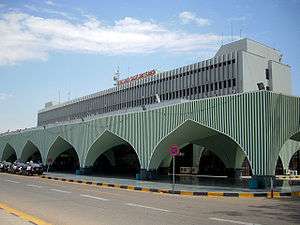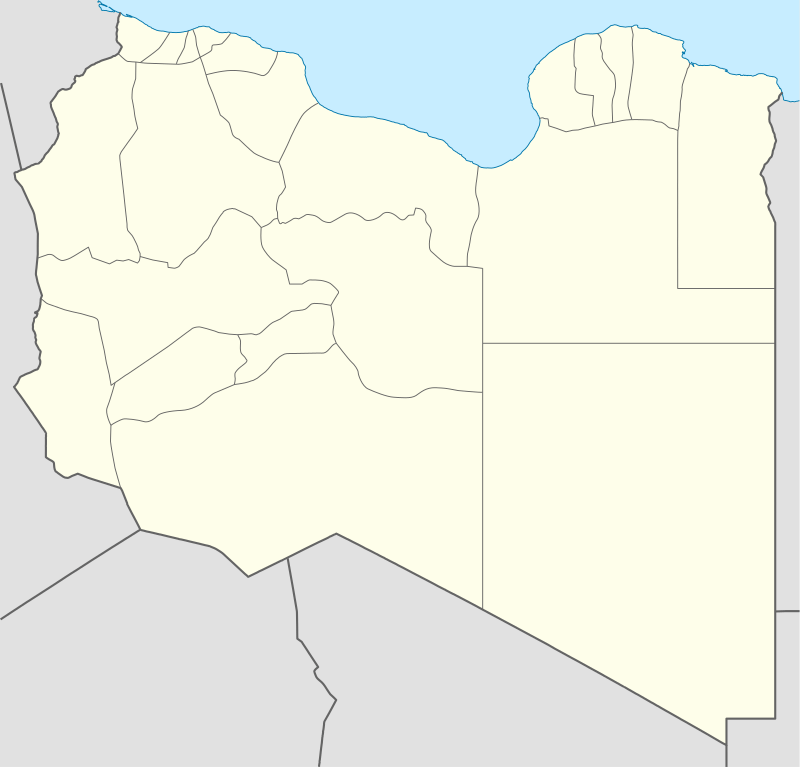Tripoli International Airport
| Tripoli International Airport مطار طرابلس العالمي | |||||||||||||||
|---|---|---|---|---|---|---|---|---|---|---|---|---|---|---|---|
 | |||||||||||||||
| Summary | |||||||||||||||
| Airport type | Public | ||||||||||||||
| Operator | Civil Aviation and Meteorology Bureau | ||||||||||||||
| Serves | Tripoli, Libya | ||||||||||||||
| Location | Qasr bin Ghashir | ||||||||||||||
| Hub for | |||||||||||||||
| Elevation AMSL | 263 ft / 80 m | ||||||||||||||
| Coordinates | 32°40′10″N 13°09′24″E / 32.66944°N 13.15667°ECoordinates: 32°40′10″N 13°09′24″E / 32.66944°N 13.15667°E | ||||||||||||||
| Map | |||||||||||||||
 TIP Location within Libya | |||||||||||||||
| Runways | |||||||||||||||
| |||||||||||||||
| Statistics (2008) | |||||||||||||||
| |||||||||||||||
Tripoli International Airport (IATA: TIP, ICAO: HLLT) (Arabic: مطار طرابلس العالمي) is an international airport built to serve Tripoli, the capital city of Libya. The airport is located in the area of Qasr bin Ghashir, 24 kilometres (15 mi) from central Tripoli. It used to be the hub for Libyan Airlines, Afriqiyah Airways, and Buraq Air.
The airport has been closed intermittently since 2011 and as of early 2018,[4] flights to and from Tripoli have been using Mitiga International Airport instead.
As part of the 2014 Libyan Civil War, the airport was heavily damaged in the Battle of Tripoli Airport.[5] The airport reopened for limited commercial use in July 2017.[6]
Facilities

Terminals
The airport has one main passenger terminal that serves international and domestic departures and arrivals. The terminal hall is a five-story building with an area of 33,000 square metres (360,000 sq ft), and is capable of handling three million passengers annually. Check-in facilities are all located on the ground floor. The departure gates are located on the floor above as is the duty-free section. Beside this is a prayer room and a first-class lounge which serves business class and above on almost all airlines operating from the airport.
The airport operates 24 hours a day. There is no overnight accommodation at the airport but there are plans to build an airport hotel to serve transit flyers. A restaurant can be found on the fourth floor of the international terminal. The head office of the Libyan Civil Aviation Authority is on the airport property.[7]
The airport's cargo-handling facilities include cranes, heavy fork lifts, roller pallet lifts, and conveyor belts. There is twenty-four-hour fire protection at the airport with 112 trained personnel working at the fire station.
Navaids
The Abu Argub VOR-DME (Ident: ABU) is located 12.1 nautical miles (22.4 km) south of the airport. The Tripoli VOR-DME (Ident: TPI) is located on the field.[8][9]
Expansion plans
In September 2007, the Libyan government announced a project to upgrade and expand the airport. The eventual total cost of the project, contracted to a joint venture between Brazil's Odebrecht, TAV Construction of Turkey, Consolidated Contractors Company of Greece and Vinci Construction of France, was LD2.54 billion ($2.1 billion).[10] The project was to construct two new terminals at the airport (an East Terminal and a West Terminal) on either side of the existing International Terminal. Each of the new terminals would have been 162,000 square metres (1,740,000 sq ft) in size, and collectively they would have had a capacity of 20 million passengers and a parking lot for 4,400 vehicles. French company Aéroports de Paris designed the terminals, which were expected to serve 100 aircraft simultaneously.[11] Work started in October 2007 on the first new terminal. The initial capacity will be 6 million passengers when the first module comes into operation.[12]
Preparation was also underway for the second new terminal, which would eventually have brought the total capacity to 20 million passengers; the completed airport is expected to strengthen Libya's position as an African aviation hub.[10] Although the government identified Tripoli airport as a "fast track" project in 2007, leading to construction work starting before the design was fully developed, the project was not be finished until at least May 2011. The cost of the project had also been rising, leading to an intense round of renegotiations.[13] The project has since been halted due to the ongoing civil war that led to further damages to the airport.
Airlines and destinations
Passenger
| Airlines | Destinations |
|---|---|
| Libyan Airlines | Alexandria–Borg el Arab,[14] Amman-Queen Alia,[15] Bayda,[16] Benghazi,[17] Ghat,[18] Istanbul-Atatürk,[19] Monastir,[20] Niamey,[21] Sfax,[22] Tobruk,[23] Tunis,[24] Ubari[25] |
Cargo
| Airlines | Destinations |
|---|---|
| Emirates SkyCargo | Dubai–Al Maktoum, Frankfurt, Mexico City |
| Etihad Cargo | Abu Dhabi, Milan–Malpensa |
| Royal Jordanian Cargo | Vienna |
| Turkish Airlines Cargo | Istanbul–Atatürk, Tunis |
History
The airport was originally called Tripoli-Castel Benito Airport and was a Regia Aeronautica (Italian Air Force) airfield created in 1934 in the southern outskirts of Italian Tripoli.[26]
In 1938 the Italian Libya governor Italo Balbo enlarged the military airfield and created an international airport for civilians served by Ala Littoria, the official Italian airline: the Aeroporto di Tripoli-Castel Benito. The first international flights were to Rome, Tunis, and Malta. In 1939, a a flight from Rome to Ethiopia and Somalia, that was one of the first intercontinental flights in world history.
During World War II the airport was destroyed, but the airfield was later used by the British Royal Air Force and was named RAF Castel Benito later changing to RAF Idris in 1952. In the 1950s and 1960s the airport was named Tripoli Idris International Airport.[27][28] The airport was renovated for national and international air travel in September 1978.[29] The existing international terminal was designed and built from a masterplan developed by Sir Alexander Gibb & Partners.[30]
The airport closed from March 2011 to October 2011 as a result of United Nations Security Council establishing a no-fly zone over Libya.
The Zintan Brigade captured the airport during their advance on Tripoli on 21 August 2011. The airport was officially reopened on 11 October 2011.[31]
On 14 July 2014, the airport was the site of fierce battle as militias from the city of Misrata attempted to take control of the airport. The airport has been closed to flights since the clashes.[32][33] On 23 August 2014, after 40 days of clashes, Zintan forces, which controlled the airport, withdrew.[34] The Los Angeles Times reported that at least 90% of the airport's facilities, and 20 airplanes, were destroyed in the fighting.
While still under the control of Misrata militias, the VIP terminal which suffered less destruction was reopened on 16 February 2017. A new passenger terminal is in planning by the political body representing the militias.[35][36]
See also
References
- ↑ Airport information for Tripoli International Airport at Great Circle Mapper.
- ↑ "Tripoli International Airport". Google Maps. Google. Retrieved 21 September 2018.
- ↑ "Tripoli International Airport". SkyVector. Retrieved 21 September 2018.
- ↑ "Foreign travel advice Libya". UK Government. Retrieved October 31, 2016.
- ↑ "Tripoli airport 'seized by Islamist militia'". www.aljazeera.com. Retrieved 2018-08-21.
- ↑ "Smartraveller.gov.au - Libya". smartraveller.gov.au. Retrieved 2018-01-08.
- ↑ "Contact" (Archive). Libyan Civil Aviation Authority. Retrieved on 30 August 2014. "مطار طرابلس الدولي - طريق المطار - طرابلس - ليبيا" ("Tripoli International Airport - Airport Road - Tripoli - Libya")
- ↑ "Tripoli VOR". Our Airports. Retrieved 21 September 2018.
- ↑ "Abu Argub VOR". Our Airports. Retrieved 21 September 2018.
- 1 2 (20 May 2008). Endres, Gunter (20 May 2008). "Libya To Restructure Air Transport Sector". flightglobal.com. Retrieved 30 May 2008.
- ↑ "TAV To Build International Airport at Libya's Capital" Archived 16 November 2007 at the Wayback Machine.. Turkish Daily News. 22 August 2007.
- ↑ Flying Away, (12 February 2008)"وضع حجر الأساس لصالة ركاب مطار طرابلس العالمي الجديد " Archived 17 February 2008 at the Wayback Machine. (in Arabic). flyingaway.com. Retrieved 2 March 2008.
- ↑ (27 August 2009). "Tripoli Makes Up for Lost Time in Construction Sector". MEED (from BDP Project Logistics). Retrieved 22 January 2010.
- ↑ http://info.flightmapper.net/flight/Libyan_Airlines_LN_210
- ↑ http://info.flightmapper.net/flight/Libyan_Airlines_LN_282
- ↑ http://info.flightmapper.net/flight/Libyan_Airlines_LN_696
- ↑ http://info.flightmapper.net/flight/Libyan_Airlines_LN_614
- ↑ http://info.flightmapper.net/flight/Libyan_Airlines_LN_630
- ↑ http://info.flightmapper.net/flight/Libyan_Airlines_LN_192
- ↑ http://info.flightmapper.net/flight/Libyan_Airlines_LN_332
- ↑ https://kvikr.com/flight/ln423_libyan_airlines
- ↑ http://info.flightmapper.net/flight/Libyan_Airlines_LN_310
- ↑ http://info.flightmapper.net/flight/Libyan_Airlines_LN_690
- ↑ http://info.flightmapper.net/flight/Libyan_Airlines_LN_302
- ↑ http://info.flightmapper.net/flight/Libyan_Airlines_LN_698
- ↑ Photo of the Tripoli-Castel Benito airport with a SM-74 Archived 27 October 2014 at the Wayback Machine.
- ↑ Tripoli Idris Airport. Retrieved 15 December 2007.
- ↑ Tripoli Idris International Airport. Retrieved 15 December 2007.
- ↑ "Tripoli International Airport" Archived 29 September 2007 at the Wayback Machine.. LYCAA. Retrieved 1 November 2006.
- ↑ "Wayback Machine" (PDF). 2006-02-13. Retrieved 2018-08-21.
- ↑ "Libya's NTC fighters stage final advance in Sirte holdout - CNN.com". CNN. 12 October 2011.
- ↑ New rocket attack on Tripoli airport BBC News. 15 July 2014.
- ↑ 90% of aircraft destroyed at Tripoli airport, Libya may seek international assistance RT. 15 July 2014.
- ↑ Chris Stephen and Anne Penketh (24 August 2014). "Libyan capital under authorities control after Tripoli airport retrieved". The Guardian.
- ↑ "Ghwell in grand reopening of Tripoli International Airport". www.libyaherald.com. Retrieved 2018-08-21.
- ↑ "Ghwell in grand reopening of Tripoli International Airport". www.libyaherald.com. Retrieved 2018-08-21.
External links
| Wikimedia Commons has media related to Tripoli International Airport. |
- OpenStreetMap - Tripoli
- Airport information for Tripoli International Airport at World Aero Data. Data current as of October 2006.
- Accident history for Tripoli International Airport at Aviation Safety Network